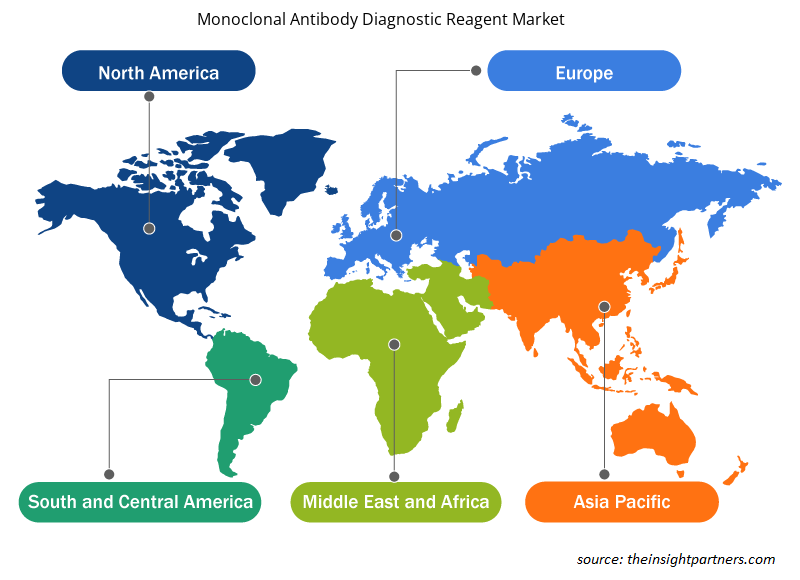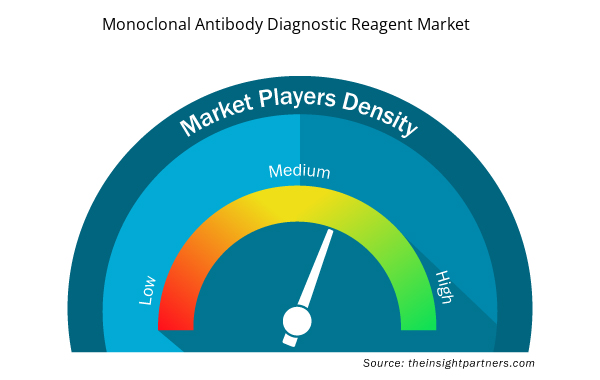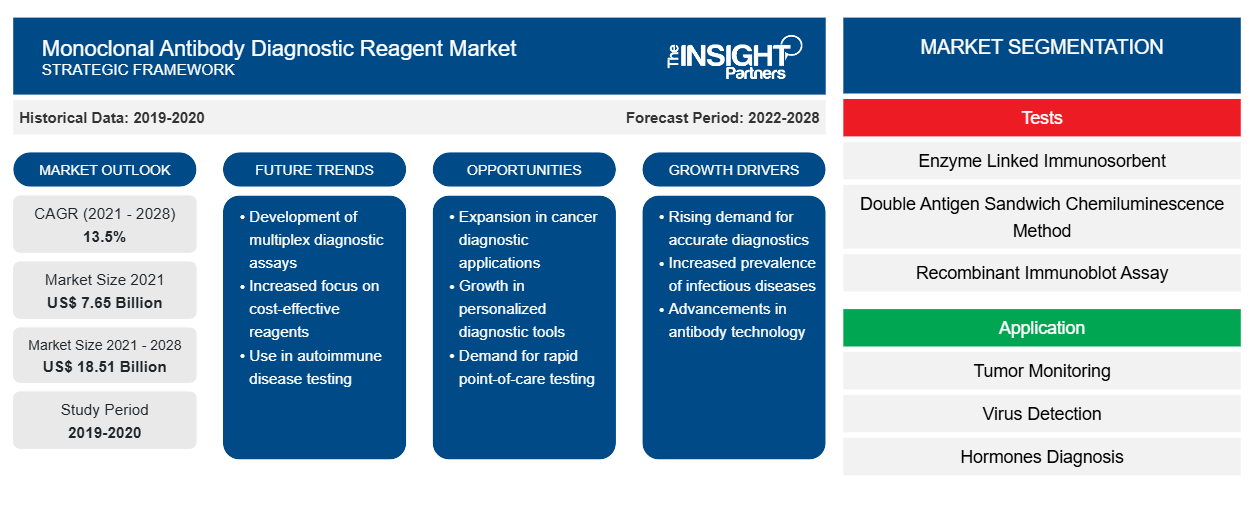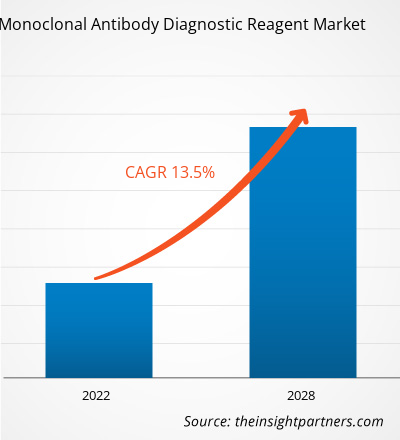Nel 2021, il mercato globale dei reagenti diagnostici basati su anticorpi monoclonali è stato valutato 7.654,06 milioni di dollari USA; si stima che crescerà a un CAGR del 13,5% dal 2022 al 2028.
Gli anticorpi monoclonali (mAb) sono importanti reagenti diagnostici utilizzati nella ricerca biomedica, nella ricerca microbiologica, nella diagnosi di epatite, AIDS, influenza, herpes simplex, infezioni da clamidia e nel trattamento di infezioni e cancro. Gli anticorpi monoclonali diretti a singoli epitopi sono altamente specifici, omogenei e possono essere prodotti in quantità illimitate. La tecnologia degli anticorpi monoclonali derivati da ibridomi o clonati battericamente ha consentito la produzione in serie di sonde altamente specifiche per siti antigenici, siano essi su ormoni, enzimi, recettori o prodotti microbici. I principali fattori che guidano la crescita di questo mercato includono la crescente prevalenza di cancro e altre malattie croniche, la presenza di una solida pipeline di farmaci in fase di sperimentazione e ampi sforzi di ricerca e sviluppo per sviluppare nuove terapie.
Il rapporto offre approfondimenti e analisi approfondite del mercato globale dei reagenti diagnostici per anticorpi monoclonali , sottolineando vari parametri, tra cui tendenze di mercato, progressi tecnologici, dinamiche di mercato e analisi del panorama competitivo dei principali attori del mercato globale. Include anche l'impatto della pandemia di COVID-19 sul mercato in tutte le regioni.
L'impatto complessivo della pandemia di COVID-19 sul mercato dei reagenti diagnostici con anticorpi monoclonali è stato positivo; pertanto, il mercato continua a guadagnare terreno e si prevede che crescerà nei prossimi anni. Celltrion Group ha annunciato che il Ministero coreano per la sicurezza alimentare e dei farmaci (MFDS) ha approvato regdanvimab (CT-P59), un anticorpo monoclonale per il trattamento del COVID-19 per l'uso prolungato in pazienti anziani di età pari o superiore a 50 anni o con almeno una condizione medica sottostante come obesità, malattie cardiovascolari, malattie polmonari croniche, diabete, malattie renali croniche , malattie epatiche croniche e pazienti con agenti immunosoppressori con sintomi lievi di COVID-19 e pazienti adulti con sintomi moderati di COVID-19. Inoltre, la terapia con anticorpi monoclonali, che è stata utilizzata con successo in altri paesi per trattare pazienti COVID-19 con sintomi lievi o moderati, è stata ora approvata dal Drugs Controller General of India (DCGI) per l'uso in India.
Personalizza questo report in base alle tue esigenze
Riceverai la personalizzazione gratuita di qualsiasi report, comprese parti di questo report, o analisi a livello nazionale, pacchetto dati Excel, oltre a usufruire di grandi offerte e sconti per start-up e università
- Scopri le principali tendenze di mercato in questo rapporto.Questo campione GRATUITO includerà analisi di dati che spaziano dalle tendenze di mercato alle stime e alle previsioni.
Approfondimenti basati sulla geografia
In base alla geografia, il mercato globale dei reagenti diagnostici per anticorpi monoclonali è suddiviso in Nord America (Stati Uniti, Canada e Messico), Europa (Francia, Germania, Regno Unito, Spagna, Russia, Italia e resto d'Europa), Asia Pacifico (Cina, India, Giappone, Australia, Corea del Sud, Kazakistan e resto dell'APAC), Medio Oriente e Africa (Arabia Saudita, Emirati Arabi Uniti, Sudafrica e resto del Medio Oriente e dell'Africa) e Sud e Centro America (Brasile, Argentina e resto del Sud e Centro America).APAC), the Middle East & Africa (Saudi Arabia, the UAE, South Africa, and the Rest of Middle East & Africa), and South & Central America (Brazil, Argentina, and the Rest of South & Central America).
Approfondimenti di mercato
Grandi sforzi di ricerca e sviluppo per sviluppare nuove terapie
Le numerose applicazioni degli mAb riguardano la prevenzione, la diagnosi e il trattamento delle malattie. L'applicazione degli mAb nella diagnosi è la più avanzata, in particolare per i test eseguiti sui fluidi corporei come urina e sangue. Inoltre, l'applicazione diagnostica degli mAb include tecniche come ELISA, western blot, immunoblot blot, citometria a flusso, immunoistochimica, test radioimmunologici e microscopia elettronica. Inoltre, gli mAb destinati all'applicazione diagnostica possono rilevare antigeni e anticorpi contro malattie virali e fungine del bestiame e malattie parassitarie.
Inoltre, gli mAb sono reagenti apprezzati destinati ad applicazioni abbondanti grazie alla loro selettività, elevata affinità di legame e immunogenicità/bassa tossicità; gli mAb sono più adatti per la ricerca clinica, ambientale ed elementare. Le applicazioni diagnostiche degli mAb includono anche dispositivi medici, test in vitro e imaging medico
Inoltre, l'utilità degli mAb si è ampliata per comprendere una serie di malattie contribuendo allo sviluppo di nuovi trattamenti di immunoterapia. Ad esempio, le terapie contro il cancro hanno beneficiato della ricerca con gli mAb, molto probabilmente per lo sviluppo di RituximAb, dimostrandosi un trattamento efficace per molti tumori. Inoltre, molti mAb sono ora riconosciuti dalla Food and Drug Administration (FDA) statunitense come sicuri per l'utilizzo in terapie commerciali. Si prevede che tali fattori sopra menzionati contribuiranno alla crescita del mercato dei reagenti diagnostici per anticorpi monoclonali durante il periodo di previsione.
Approfondimenti regionali sul mercato dei reagenti diagnostici per anticorpi monoclonali
Le tendenze regionali e i fattori che influenzano il mercato dei reagenti diagnostici per anticorpi monoclonali durante il periodo di previsione sono stati ampiamente spiegati dagli analisti di Insight Partners. Questa sezione discute anche i segmenti e la geografia del mercato dei reagenti diagnostici per anticorpi monoclonali in Nord America, Europa, Asia Pacifico, Medio Oriente e Africa e America meridionale e centrale.

- Ottieni i dati specifici regionali per il mercato dei reagenti diagnostici per anticorpi monoclonali
Ambito del rapporto di mercato dei reagenti diagnostici per anticorpi monoclonali
| Attributo del report | Dettagli |
|---|---|
| Dimensioni del mercato nel 2021 | 7,65 miliardi di dollari USA |
| Dimensioni del mercato entro il 2028 | 18,51 miliardi di dollari USA |
| CAGR globale (2021 - 2028) | 13,5% |
| Dati storici | 2019-2020 |
| Periodo di previsione | 2022-2028 |
| Segmenti coperti | Per test
|
| Regioni e Paesi coperti | America del Nord
|
| Leader di mercato e profili aziendali chiave |
|
Densità dei player del mercato dei reagenti diagnostici per anticorpi monoclonali: comprendere il suo impatto sulle dinamiche aziendali
Il mercato dei reagenti diagnostici per anticorpi monoclonali sta crescendo rapidamente, spinto dalla crescente domanda degli utenti finali dovuta a fattori quali l'evoluzione delle preferenze dei consumatori, i progressi tecnologici e una maggiore consapevolezza dei benefici del prodotto. Con l'aumento della domanda, le aziende stanno ampliando le loro offerte, innovando per soddisfare le esigenze dei consumatori e capitalizzando sulle tendenze emergenti, il che alimenta ulteriormente la crescita del mercato.
La densità degli operatori di mercato si riferisce alla distribuzione di aziende o società che operano in un particolare mercato o settore. Indica quanti concorrenti (operatori di mercato) sono presenti in un dato spazio di mercato in relazione alle sue dimensioni o al valore di mercato totale.
Le principali aziende che operano nel mercato dei reagenti diagnostici per anticorpi monoclonali sono:
- BioGenex
- Laboratori Bio-Rad, Inc.
- Azienda Biocare Medical, LLC
- Azienda sanitaria Celltrion
- Diagnostica creativa
Disclaimer : le aziende elencate sopra non sono classificate secondo un ordine particolare.

- Ottieni la panoramica dei principali attori del mercato dei reagenti diagnostici per anticorpi monoclonali
Approfondimenti basati sui test
Sulla base dei test, il mercato globale dei reagenti diagnostici per anticorpi monoclonali è suddiviso in metodo di chemiluminescenza a sandwich con doppio antigene, saggio immunoenzimatico, saggio immunoblot ricombinante e saggio di filtrazione dot-immunogold. Nel 2021, il segmento del saggio immunoenzimatico ha rappresentato la quota di mercato maggiore e si prevede che registrerà il CAGR più elevato dal 2022 al 2028.
Approfondimenti basati sulle applicazioni
In base all'applicazione, il mercato globale dei reagenti diagnostici per anticorpi monoclonali è segmentato in diagnosi ormonale, monitoraggio dei tumori, rilevamento dei virus e altre applicazioni. Il segmento del monitoraggio dei tumori ha detenuto la quota di mercato maggiore nel 2021 e si prevede che registrerà il CAGR più elevato durante il periodo di previsione.
I player globali del mercato dei reagenti diagnostici per anticorpi monoclonali stanno adottando strategie organiche, tra cui il lancio e l'espansione dei prodotti, per espandere la loro presenza e il portafoglio prodotti in tutto il mondo e soddisfare la crescente domanda di prodotti. Alcuni dei principali player che operano nel mercato sono BioGenex; Bio-Rad Laboratories, Inc.; Biocare Medical, LLC; Celltrion Healthcare Co., Ltd.; Creative Diagnostics; GenWay Biotech; Thermo Fisher Scientific Inc.; ABclonal, Inc.; Apto-Gen; e Abcam plc.
- Analisi storica (2 anni), anno base, previsione (7 anni) con CAGR
- Analisi PEST e SWOT
- Valore/volume delle dimensioni del mercato - Globale, regionale, nazionale
- Industria e panorama competitivo
- Set di dati Excel



Report Coverage
Revenue forecast, Company Analysis, Industry landscape, Growth factors, and Trends

Segment Covered
This text is related
to segments covered.

Regional Scope
North America, Europe, Asia Pacific, Middle East & Africa, South & Central America

Country Scope
This text is related
to country scope.
Domande frequenti
The enzyme-linked immunosorbent assay segment held the largest share of the market in the global monoclonal antibody diagnostic reagent market contributing a market share of 37.89% in 2021.
The Asia Pacific is expected to be the fastest-growing region in the monoclonal antibody diagnostic reagent market over the forecast period due to growing investments from international players in China and India, increasing disposable income, and chronic diseases in these regions will show promising growth in the monoclonal antibody diagnostic reagent market.
The monoclonal antibody diagnostic reagent market is expected to be valued at US$ 18,507.20 million in 2028.
The CAGR value of the monoclonal antibody diagnostic reagent market during the forecasted period of 2022-2028 is 13.5%
The monoclonal antibody diagnostic reagent market is estimated to be valued at US$ 8,642.00 million in 2022.
The monoclonal antibody diagnostic reagent market majorly consists of the players, such as BioGenex; Bio-Rad Laboratories, Inc.; Biocare Medical, LLC; Celltrion Healthcare Co., Ltd.; Creative Diagnostics; GenWay Biotech; Thermo Fisher Scientific Inc.; ABclonal, Inc.; Apto-Gen; and Abcam plc.
Rising prevalence of cancer and other chronic diseases, extensive R&D efforts to develop novel therapies, and presence of strong pipeline of drugs under trial are the major factors contributing to the growth of the monoclonal antibody diagnostic reagent industry.
Monoclonal antibodies (mAb) are important diagnostic reagents that are being used in biomedical research, microbiological research in diagnosis of Hepatitis, AIDs, influenza, herpes simplex, chlamydia infections and in treatment of infections and cancer. The monoclonal antibodies being directed against single epitopes are highly specific, homogeneous and can be produced in unlimited quantities. The hybridoma-derived or bacterially cloned monoclonal antibody technology has enabled the mass production of highly specific probes for antigenic sites, whether on hormones, enzymes, receptors, or microbial products.
Trends and growth analysis reports related to Life Sciences : READ MORE..
The List of Companies - Monoclonal Antibody Diagnostic Reagent Market
- BioGenex
- Bio-Rad Laboratories, Inc.
- Biocare Medical, LLC
- Celltrion Healthcare Co., Ltd.
- Creative Diagnostics
- GenWay Biotech
- Thermo Fisher Scientific Inc.
- ABclonal, Inc.
- Apto-Gen
- Abcam plc.
The Insight Partners performs research in 4 major stages: Data Collection & Secondary Research, Primary Research, Data Analysis and Data Triangulation & Final Review.
- Data Collection and Secondary Research:
As a market research and consulting firm operating from a decade, we have published and advised several client across the globe. First step for any study will start with an assessment of currently available data and insights from existing reports. Further, historical and current market information is collected from Investor Presentations, Annual Reports, SEC Filings, etc., and other information related to company’s performance and market positioning are gathered from Paid Databases (Factiva, Hoovers, and Reuters) and various other publications available in public domain.
Several associations trade associates, technical forums, institutes, societies and organization are accessed to gain technical as well as market related insights through their publications such as research papers, blogs and press releases related to the studies are referred to get cues about the market. Further, white papers, journals, magazines, and other news articles published in last 3 years are scrutinized and analyzed to understand the current market trends.
- Primary Research:
The primarily interview analysis comprise of data obtained from industry participants interview and answers to survey questions gathered by in-house primary team.
For primary research, interviews are conducted with industry experts/CEOs/Marketing Managers/VPs/Subject Matter Experts from both demand and supply side to get a 360-degree view of the market. The primary team conducts several interviews based on the complexity of the markets to understand the various market trends and dynamics which makes research more credible and precise.
A typical research interview fulfils the following functions:
- Provides first-hand information on the market size, market trends, growth trends, competitive landscape, and outlook
- Validates and strengthens in-house secondary research findings
- Develops the analysis team’s expertise and market understanding
Primary research involves email interactions and telephone interviews for each market, category, segment, and sub-segment across geographies. The participants who typically take part in such a process include, but are not limited to:
- Industry participants: VPs, business development managers, market intelligence managers and national sales managers
- Outside experts: Valuation experts, research analysts and key opinion leaders specializing in the electronics and semiconductor industry.
Below is the breakup of our primary respondents by company, designation, and region:

Once we receive the confirmation from primary research sources or primary respondents, we finalize the base year market estimation and forecast the data as per the macroeconomic and microeconomic factors assessed during data collection.
- Data Analysis:
Once data is validated through both secondary as well as primary respondents, we finalize the market estimations by hypothesis formulation and factor analysis at regional and country level.
- Macro-Economic Factor Analysis:
We analyse macroeconomic indicators such the gross domestic product (GDP), increase in the demand for goods and services across industries, technological advancement, regional economic growth, governmental policies, the influence of COVID-19, PEST analysis, and other aspects. This analysis aids in setting benchmarks for various nations/regions and approximating market splits. Additionally, the general trend of the aforementioned components aid in determining the market's development possibilities.
- Country Level Data:
Various factors that are especially aligned to the country are taken into account to determine the market size for a certain area and country, including the presence of vendors, such as headquarters and offices, the country's GDP, demand patterns, and industry growth. To comprehend the market dynamics for the nation, a number of growth variables, inhibitors, application areas, and current market trends are researched. The aforementioned elements aid in determining the country's overall market's growth potential.
- Company Profile:
The “Table of Contents” is formulated by listing and analyzing more than 25 - 30 companies operating in the market ecosystem across geographies. However, we profile only 10 companies as a standard practice in our syndicate reports. These 10 companies comprise leading, emerging, and regional players. Nonetheless, our analysis is not restricted to the 10 listed companies, we also analyze other companies present in the market to develop a holistic view and understand the prevailing trends. The “Company Profiles” section in the report covers key facts, business description, products & services, financial information, SWOT analysis, and key developments. The financial information presented is extracted from the annual reports and official documents of the publicly listed companies. Upon collecting the information for the sections of respective companies, we verify them via various primary sources and then compile the data in respective company profiles. The company level information helps us in deriving the base number as well as in forecasting the market size.
- Developing Base Number:
Aggregation of sales statistics (2020-2022) and macro-economic factor, and other secondary and primary research insights are utilized to arrive at base number and related market shares for 2022. The data gaps are identified in this step and relevant market data is analyzed, collected from paid primary interviews or databases. On finalizing the base year market size, forecasts are developed on the basis of macro-economic, industry and market growth factors and company level analysis.
- Data Triangulation and Final Review:
The market findings and base year market size calculations are validated from supply as well as demand side. Demand side validations are based on macro-economic factor analysis and benchmarks for respective regions and countries. In case of supply side validations, revenues of major companies are estimated (in case not available) based on industry benchmark, approximate number of employees, product portfolio, and primary interviews revenues are gathered. Further revenue from target product/service segment is assessed to avoid overshooting of market statistics. In case of heavy deviations between supply and demand side values, all thes steps are repeated to achieve synchronization.
We follow an iterative model, wherein we share our research findings with Subject Matter Experts (SME’s) and Key Opinion Leaders (KOLs) until consensus view of the market is not formulated – this model negates any drastic deviation in the opinions of experts. Only validated and universally acceptable research findings are quoted in our reports.
We have important check points that we use to validate our research findings – which we call – data triangulation, where we validate the information, we generate from secondary sources with primary interviews and then we re-validate with our internal data bases and Subject matter experts. This comprehensive model enables us to deliver high quality, reliable data in shortest possible time.


 Ottieni un campione gratuito per questo repot
Ottieni un campione gratuito per questo repot